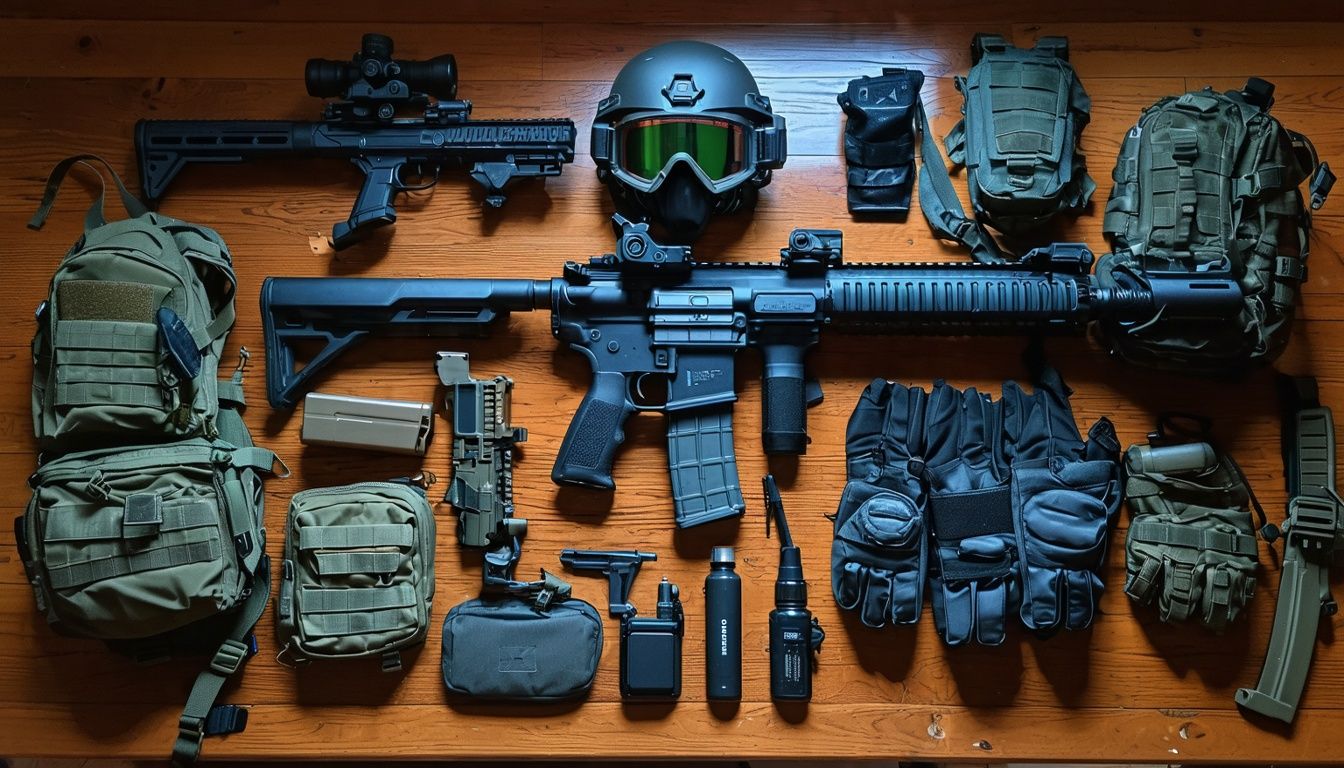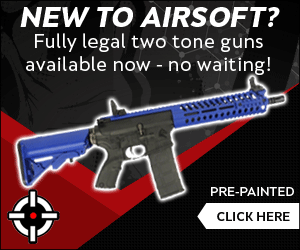Airsoft hostage rescue games are thrilling, but many players struggle with strategy. Teams often fail missions due to poor planning and communication. This guide will help you master the art of hostage rescue in airsoft.
Did you know? The FBI’s Hostage Rescue Team trains for over 800 hours yearly. Our guide distils key tactics from real-world operations into actionable airsoft strategies. You’ll learn team roles, gear selection, and winning tactics.
Ready to become an airsoft hostage rescue expert?
Understanding the Hostage Rescue Game Mode
Hostage Rescue mode pits SWAT against terrorists in a high-stakes battle. SWAT’s mission: extract a weighted dummy hostage to their spawn point. Terrorists must prevent this at all costs.
The game unfolds over two 30-minute periods, with SWAT enjoying unlimited respawns in D-Block. Terrorists, however, get no second chances – once eliminated, they’re out for good.
Gear restrictions add tactical depth. Both teams must use semi-automatic guns, forcing precise shots and careful movement. SWAT’s constant insertion point creates a focal point for intense firefights.
Terrorists face the challenge of guarding their hidden hostage while repelling waves of attackers. This asymmetrical setup demands teamwork, strategy, and quick thinking from both sides.
Rules and Regulations for Hostage Rescue
Rules and regulations ensure fair play and safety in airsoft hostage rescue scenarios. Here’s a comprehensive list of guidelines for this intense game mode:
- Safety first: All players must wear full face protection and event wristbands at all times.
- Team composition: SWAT teams limited to 10 members, including 2 snipers. Terrorist team capped at 8 players.
- Time limit: 30-minute rounds, with a 5-minute briefing before each game.
- Hostage treatment: No physical contact with hostages. Verbal commands only.
- Building integrity: No altering structures or hanging limbs out of windows.
- Weapons: SWAT uses airsoft replicas of FBI HRT gear. Terrorists limited to AK-style rifles and pistols.
- Respawn rules: No respawns for either team during the round.
- Win conditions: SWAT wins by rescuing all hostages. Terrorists win by eliminating SWAT or time expiry.
- Stealth emphasis: SWAT must use covert entry tactics. No breaching charges allowed.
- Communication: Radio silence enforced until first contact. Thereafter, tactical comms permitted.
- Snipers: SWAT snipers must remain within designated overwatch positions.
- Hostage movement: Terrorists can move hostages once per round, with a 30-second relocation time.
- Surrender option: Terrorists can surrender, ending the round immediately.
- Medic rule: One SWAT member designated as medic, can revive teammates once per round.
- Referee authority: Game organisers can modify rules for safety or fairness at any time.
Team Member Roles in Hostage Rescue
Team members in hostage rescue operations have specific roles. The team leader coordinates and makes strategic decisions. Snipers provide long-range support and gather intel. Entry specialists breach doors and clear rooms.
Negotiators communicate with hostage-takers. Medics offer emergency care. Each role requires specialised training and equipment.
FBI special agents and SWAT officers fill these roles in real scenarios. In airsoft, players simulate these positions for added realism. Effective communication between roles is crucial.
Teams must work cohesively under pressure. Proper gear and tactical knowledge are essential for success in both real and simulated hostage rescues.
Gear and Equipment for Hostage Rescue
Proper gear and equipment are crucial for successful airsoft hostage rescue operations. Here’s a comprehensive list of essential items for your ultimate HRT loadout:
- Airsoft rifle: Choose a high-quality replica like the Remington Model 700 for accuracy and range
- Tactical vest: Opt for a lightweight, modular design with multiple pouches for versatility
- Combat uniform: Crye Precision G3 shirt and trousers offer comfort and durability
- Gloves: Mechanix Wear M-Pact 3 Covert gloves provide dexterity and protection
- Footwear: Lowa Zephyr GTX High TF black boots ensure stability and ankle support
- Eye protection: ANSI Z87.1-rated goggles or full-face mask for safety
- Helmet: Ballistic-style replica with night vision mount for authenticity
- Communication gear: Two-way radio and earpiece for team coordination
- Tactical light: Weapon-mounted or handheld for low-light scenarios
- Replica sidearm: Backup weapon for close-quarters engagement
- Knee and elbow pads: Added protection during dynamic movements
- Hydration system: Integrated or separate for extended operations
- First aid kit: Compact medical supplies for emergencies
- Multi-tool: Versatile tool for gear adjustments and minor repairs
- Tactical backpack: Small, low-profile bag for extra supplies
Tips for Hostage Rescue Success
Success in hostage rescue hinges on sharp skills and smart tactics. These tips will boost your team’s performance and give you the edge in high-stakes airsoft games.
Techniques for Effective Communication
Clear communication is vital in airsoft hostage rescue scenarios. Teams must utilise hand signals, speech, and radio comms effectively. In CQB environments, hand signals and Bluetooth-style devices prove invaluable.
Pre-game planning sessions ensure all members understand the communication strategy.
Radio battery management is crucial for uninterrupted comms. Teams should test their systems in the play area before the game starts. Post-game debriefs allow squads to analyse communication successes and failures, improving future performance.
Strategies for Tactical Planning and Execution
Effective tactical planning and execution are crucial for successful hostage rescue operations. These strategies enhance team performance and mission outcomes:
- Gather intelligence: Collect detailed information about the hostage situation, location, and captors. Use satellite imagery, surveillance, and informants to build a comprehensive picture.
- Develop multiple plans: Create primary and backup strategies to adapt to changing circumstances. Account for various scenarios and potential obstacles.
- Assign clear roles: Designate specific tasks for each team member, including entry, negotiation, and sniper positions. Ensure everyone understands their responsibilities.
- Rehearse extensively: Conduct full-scale simulations of the operation using mock-ups of the target area. Practice different scenarios to improve team coordination.
- Establish communication protocols: Implement secure, reliable communication systems for real-time updates. Use code words and hand signals to maintain operational security.
- Employ deception tactics: Utilise diversionary techniques to mislead hostage-takers. Create distractions to facilitate covert entry and surprise attacks.
- Prioritise speed and surprise: Execute the plan swiftly to maintain the element of surprise. Minimise the time between initial breach and hostage extraction.
- Coordinate with support units: Liaise with local law enforcement, medical teams, and other relevant agencies. Ensure seamless integration of all supporting elements.
- Use specialised equipment: Deploy advanced tools like thermal imaging cameras, breaching devices, and non-lethal weapons. Equip team members with appropriate gear for the specific mission.
- Maintain operational flexibility: Be prepared to adapt the plan in real-time based on new information or unexpected developments. Train team members to make quick decisions under pressure.
Overcoming Challenges in Hostage Rescue
In hostage rescue scenarios, teams face intense pressure and unpredictable situations. Communication breakdowns, time constraints, and unexpected hostage taker actions pose significant hurdles.
Successful teams employ silent hand signals, practise breach and clear tactics, and develop flexible extraction plans. They also master time management skills to execute operations swiftly and precisely.
Gear malfunctions and environmental challenges can derail even well-planned missions. Top squads conduct thorough equipment checks, adapt to varied terrains, and train in diverse conditions.
They hone their combat swimming and closed circuit diving abilities for maritime assaults. Regular drills in helicopter operations and rappelling prepare them for complex extractions.
These enhanced capabilities ensure teams can overcome obstacles in high-stakes scenarios.
Conclusion
Mastering airsoft hostage rescue demands skill, strategy, and teamwork. Players must communicate effectively, plan meticulously, and adapt swiftly. Proper gear selection enhances performance and safety.
Regular practice sharpens reflexes and decision-making. This guide equips you with essential knowledge for success in this thrilling game mode.
FAQs
What’s an Airsoft Hostage Rescue Team game mode?
It’s a MilSim-style game… players act as special forces, like Delta Force or FBI HRT. One team rescues hostages, the other defends. It’s intense, strategic – think ‘Dead by Daylight’ meets real-world tactics.
How do I gear up for this game mode?
Dress like FBI agents or SEAL Team Six. Use airsoft guns, personal protective equipment. Clothing matters – stealth is key. Some games need specific kit, like maritime ops gear.
What roles can I play in this game?
Be a hostage negotiator, HRT sniper, or part of the hostile force. Each role needs different skills. Tactical support roles exist too. It’s not just about shooting – strategy counts.
How does spawning work in this mode?
Spawning varies… Some games use ‘respawn waves’, others have one-life rules. It depends on the scenario – could be a Waco-style siege or a quick snatch-and-grab. Check your game’s mechanics.
Are there different scenarios in this game mode?
Yes! From terrorist incidents to nuclear weapon threats. Some focus on FBI Academy training, others on real-world ops. Los Angeles bank heists, maritime missions at Naval Amphibious Base – variety’s huge.
How realistic is this game mode?
It’s as real as airsoft gets. Based on actual FBI and police tactics. Games often mirror numerous operations from history. It’s not just fun – it’s a strategic planning exercise. Expect intense, immersive gameplay.










